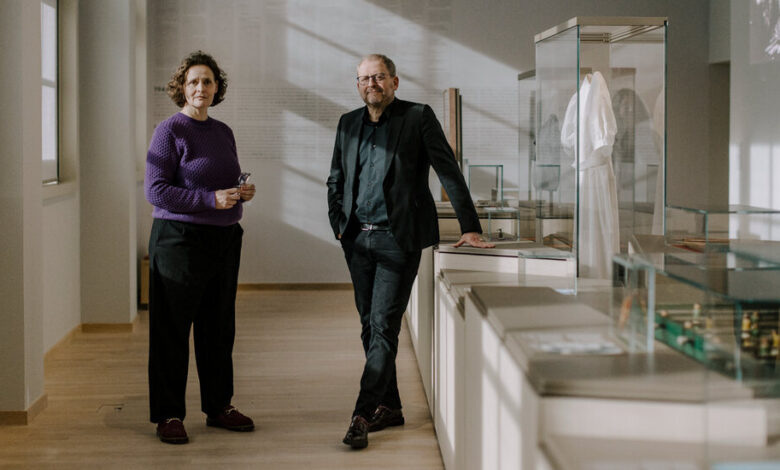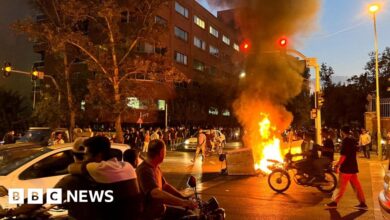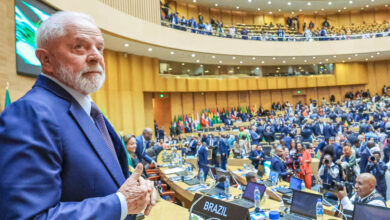With a new Holocaust Museum, the Netherlands faces its past

Three bewildered faces looked at sepia-toned passport photos, haphazardly pasted onto a card for an unknown recipient. They could be the parents and their son, but we will never know for sure. Under their photos is the handwritten note: “Don’t forget us!”
It’s unclear when the card was sent. But their appeal has helped shape the permanent collection at the National Holocaust Museum in Amsterdam, which opens to the public next week. The new organization has been in operation for nearly 20 years, during which time the project has overcome persistent skepticism due in part to hesitation in confronting this part of Dutch history.
“I think it’s a remnant of a lingering feeling of unease in the Netherlands about being held accountable for what happened,” said Emile Schrijver, general director of the National Holocaust Museum.
While other museums in the Netherlands deal with historical aspects of the Holocaust – such as the Anne Frank House or museums focusing on World War II more broadly – the National Holocaust Museum is the The first organization dedicated to telling the full story of the persecution of Jews in the Netherlands.
“Everyone agrees on the fact that the fate of the Jews in World War II was significantly different from the fate of the Netherlands, that it took a very long time,” Schrijver said. The opening of the museum “is a kind of end to a process of acceptance,” Schrijver said.
In the Netherlands, the Nazis deported 75% of the country’s Jewish population to concentration camps, the highest rate in Western Europe. The new museum aims to answer the question of how such a large group – 102,000 Jews, as well as 220 Romani people, also known as Roma and Sinti – could be excluded from their daily lives, and what life was like for those people before and, if they survived the war.
Part of the answer lies in the brutal bureaucracy established by the Nazis during their occupation and carried out by Dutch civilians and officials. On the second floor of the museum, text describing the laws against Dutch Jews is printed on the wall, inescapable and overwhelming.
Examples will appear in front of visitors, whether they intend to read them or not. November 11, 1941: Jews were no longer allowed to join tennis clubs, dance clubs or play bridge. June 11, 1942: Jews were no longer allowed to shop at the fish market. June 12, 1942: Jews had to surrender their bicycles. September 15, 1942: Jewish students are banned from universities.
“When you walk by, you can feel the oppression and the dismantling of laws and freedoms for all Jews,” said Annemiek Gringold, head of the museum. “That crime, no matter how neatly recorded in judicial documents, is always present.”
In the museum’s galleries, the lives of Dutch Jews are showcased in exhibits that include clothing, jewelry, suitcases, and other items. The goal, says Gringold, is to portray people as full-fledged individuals, rather than just victims.
“It’s the only way to do justice to someone’s memory,” Gringold said. “Otherwise someone becomes what the Nazis turned them into. We don’t want that.”
A historical reckoning has gradually become a part of Dutch society, including through apologies from the government and royal family for the Holocaust as well as the country’s role in the slave trade.
Gringold said she first proposed opening a national Holocaust museum in 2005, but at the time, many people questioned whether such a museum was necessary. Since 2015, the Jewish Cultural District, the organization that runs the museum, has hosted temporary exhibitions in the space that is now the museum. But temporary exhibits aren’t enough to tell the whole story, museum leaders said. The Jewish Cultural District purchased the building in 2021 and began renovations to transform it into a space to display a permanent collection.
The building – a former school – is located opposite a theater that the Nazis turned into a major deportation center and next to a nursery where Jewish children were held before they were sent to concentration camps central.
The museum interior, redeveloped by Amsterdam-based Winhov Architecture Office, is illuminated by natural light, filtered through soft gray curtains. This intentionally refers to how the Nazis carried out their atrocities in broad daylight for all to see.
Architect and artist Daniel Libeskind, who was not involved in this project but who has designed several major Holocaust memorials or museums, including in Berlin and Amsterdam, says that throughout his career himself, he also had to face many doubts. Libeskind said that for a long time after the war, it was difficult for people to face the shadows of the past, and the establishment of memorial facilities was left to the next generation.
Holocaust survivors in the Netherlands said the museum’s opening was an important milestone.
“I teach in schools about World War II and I always hear how little time is devoted to the Holocaust,” said Salo Muller, who survived the war by going into hiding as a 6-year-old in 1942. . from his parents after a Nazi raid, and was taken to a nursery next to the museum, but resistance fighters helped him escape. He never saw his parents again.
After a recent private visit to the museum before it opened to the public, Muller said he felt emotional. “When I walked around there, there were so many things that went through my mind,” he said. “My family was here and deported. My parents, my grandparents, my uncles and cousins. It really touched me.”
At the end of the collection, which also includes video testimonies from survivors as well as photos and videos from the extermination camps, visitors finally encounter the passport photos of three anonymous claimants. not forgotten but the name has been forgotten by history. notwithstanding.
The museum used that command – “remember us!” — as part of its own message, said Gringold, the curator. When a traveler is faced with these three individuals, it is almost impossible not to remember them.
“You can’t say you don’t know anymore,” Gringold said. “Now you know.”




